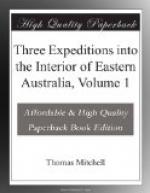THE MEN AT THE RIVER OBLIGED TO FIRE UPON THE NATIVES.
I was most anxious to know what was going on at the river, where all our horses and cattle were seen running about, but the defence of our camp required all my attention.
STEADY CONDUCT OF THE PARTY.
As soon as the firing was heard several men rushed forward as volunteers to support the party on the river and take them more ammunition. Those whose services I accepted were William Woods, Charles King, and John Johnston (the blacksmith) who all ran through the polygonum bushes with a speed that seemed to astonish even the two natives still sitting before our camp. In the meantime we made every possible preparation for defence. Robert Whiting, who was very ill and weak, crawled to a wheel; and he said that, though unable to stand, he had yet strength enough to load and fire. The shots at the river seemed renewed almost as soon as the reinforcement left us, but we were obliged to remain in ignorance of the nature and result of the attack for at least an hour after the firing had ceased. At length a man was seen emerging from the scrub near the riverbank, whose slow progress almost exhausted our patience, until, as he drew near, we saw that he was wounded and bleeding. This was Joseph Jones who had been sent for water and who, although much hurt, brought a pot and a tea-kettle full, driving the sheep before him, according to custom.
ORIGIN OF THE DISPUTE.
It now turned out that the tea-kettle which Jones carried had been the sole cause of the quarrel. As he was ascending the riverbank with the water, Thomas Jones (the sailor) being stationed on the bank, covering the other with his pistol as was usual and necessary on this journey; king Peter, who had come along the bank with several other natives, met him when halfway up, and smilingly took hold of the pot, as if meaning to assist him in carrying it up; but on reaching the top of the bank he, in the same jocose way, held it fast, until a gin said something to him, upon which he relinquished the pot and seized the kettle with his left hand, and at the same time grasping




